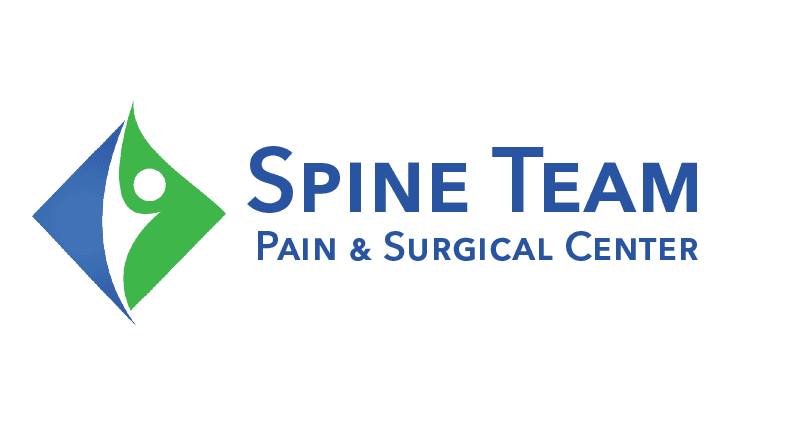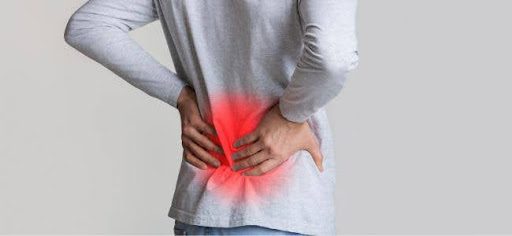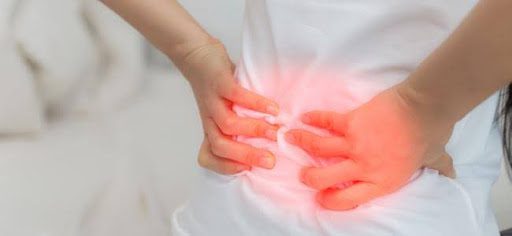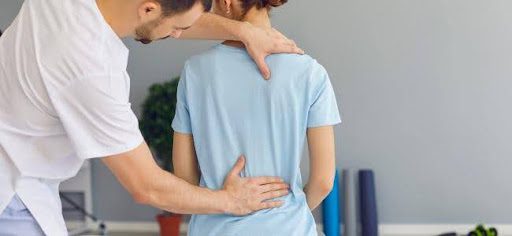Middle Back Pain Treatment: Soothe Pain & Enhance Comfort
Middle back pain can make everyday activities tough. Around 1 in 3 adults are affected by it at some point.
This article will guide you through understanding, treating, and preventing middle back discomfort.
Keep reading for relief tips!
Key Takeaways
- Middle back pain affects around 1 in 3 adults and can be caused by poor posture, obesity, muscle strain or injury, herniated discs, osteoarthritis, aging factors, and fractures.
- Treatment options for middle back pain include managing posture through ergonomic furniture and exercises that strengthen spine-supporting muscles. Medications like painkillers and muscle relaxants also help alleviate symptoms.
- Physical therapy plays a crucial role in treating middle back pain by focusing on strengthening and stretching specific muscles to reduce discomfort. Chiropractic care can realign the spine for overall improvement.
- Self - care methods such as rest along with ice and heat therapy are effective for relieving middle back discomfort. Maintaining a healthy weight can prevent extra stress on the back.
- It's important to seek medical attention if experiencing severe or persistent middle back pain especially with symptoms like numbness or weakness in legs. Early treatment prevents complications ensuring faster recovery.
Causes of Middle Back Pain
Causes of Middle Back Pain can include poor posture, obesity, muscle strain or sprain, injury, herniated disc, osteoarthritis.
Poor posture
Poor posture places extra stress on the thoracic spine, leading to middle back pain. Slouching at a desk or constantly looking down at your phone causes muscle strain and tension in the spinal cord area.
This consistent misalignment can lead to chronic back pain over time.
Correcting poor posture involves paying attention to how you sit, stand, and move throughout the day. Using ergonomic furniture and practicing exercises that strengthen the muscles supporting your spine can relieve pain caused by poor posture.
Engaging in physical therapy sessions also helps adjust your body's alignment, lessening the strain on your thoracic spine and surrounding muscles.
Obesity
Obesity increases the risk of developing middle back pain by putting extra pressure on the spine and muscles in the back. Excess body weight can lead to muscle strain, adding to the discomfort experienced in the middle back area.
This added stress can exacerbate conditions such as herniated discs or osteoarthritis, contributing further to severe middle back pain.
Maintaining a healthy weight is crucial for reducing this pressure on the spine and preventing issues that can cause or worsen middle back pain. Exercises targeting muscle strength and flexibility support spinal health and help manage symptoms related to obesity-induced back problems.
Muscle strain or sprain
Muscle strain or sprain in the middle back often happens due to sudden movements, lifting heavy objects incorrectly, or being in an awkward position for too long. These actions can stretch muscles and ligaments beyond their normal range, leading to pain and discomfort.
Symptoms might include muscle tension, limited mobility around the thoracic and lumbar spine, and even pain when taking deep breaths.
Treatment for a muscle strain or sprain typically involves rest, ice to reduce swelling during the first couple of days followed by heat therapy to relax muscles. Gentle exercises and stretching under the guidance of a physical therapist can also help strengthen back muscles and prevent future injuries.
Over time, most people see significant improvements in their symptoms with proper care.
Injury
An injury to the middle back can result from car accidents, sports-related mishaps, or heavy lifting. It may lead to muscle strain, rib fractures, or herniated discs. Seeking immediate medical attention for severe pain and discomfort is crucial to prevent further complications.
Treatment often involves rest, ice therapy, physical therapy exercises tailored towards strengthening the affected area.
In some cases of middle back injuries where the pain persists or intensifies over time, seeking treatment from a healthcare professional is recommended. It's important not to ignore persistent pain in this region as it could indicate more serious underlying issues that require prompt medical intervention.
Herniated disc
A herniated disc occurs when the soft center of a spinal disc pushes through a crack in the tougher exterior casing. This can put pressure on nearby nerves, causing middle back pain, numbness, or weakness.
Treatment may include rest, physical therapy, and in some cases, surgery to relieve pressure on the affected nerve.
Moving onto medical treatment for middle back pain..
Osteoarthritis
Transitioning from herniated disc to osteoarthritis, we delve into the realm of a common cause of middle back pain. Osteoarthritis, also known as degenerative joint disease, occurs when the cartilage between joints deteriorates and bone grows over it.
This process often affects the spine's facet joints and can result in bone spurs that impinge on spinal nerves, causing pain. Additionally, this condition can lead to stiffness and decreased mobility within the rib cage.
The progression of osteoarthritis triggers chronic pain that may be aggravated by movement or physical activities. It is crucial to seek appropriate medical treatment and self-care strategies when managing middle back pain associated with osteoarthritis to alleviate discomfort and maintain spinal health.
Aging
Transitioning from the effects of osteoarthritis, aging also plays a significant role in middle back pain. As we age, the spinal discs lose hydration and elasticity, leading to reduced shock absorption between vertebrae.
This can result in discomfort and pain in the middle back region. Additionally, aging can contribute to degenerative changes such as bone spurs and arthritis that may lead to middle back pain.
The natural process of aging causes wear and tear on the spine, impacting its flexibility and strength over time. These age-related changes can increase the likelihood of experiencing middle back discomfort or pain as individuals grow older.
Fractures
Fractures in the middle back can result from significant trauma or injury, such as a car accident or a fall from height. They can also occur due to osteoporosis weakening the vertebrae over time.
If a fracture is suspected, seek medical attention immediately. A doctor will likely order imaging tests like an X-ray or MRI to diagnose and determine the severity of the fracture.
Treatment may involve wearing a brace or corset to stabilize the spine while healing takes place, and in severe cases, surgery may be necessary to restore stability.
Medical Treatment for Middle Back Pain
Medical professionals can prescribe medications such as painkillers, muscle relaxants, and steroid injections to alleviate middle back pain. They may also recommend physical therapy, chiropractic care, or acupuncture for effective relief.
Prescription medications (painkillers, muscle relaxants, steroid injections)
Prescription medications such as painkillers, muscle relaxants, and steroid injections can help alleviate middle back pain. They work by blocking pain signals and reducing muscle spasms, allowing for relief and improved mobility.
- Painkillers: Over-the-counter or prescription pain relievers like ibuprofen, acetaminophen, or naproxen can provide temporary relief from mild to moderate back pain.
- Muscle relaxants: These medications help reduce muscle spasms in the back, promoting relaxation and decreasing discomfort.
- Steroid injections: Injections of corticosteroids directly into the affected area can effectively reduce inflammation and alleviate severe back pain.
Physical therapy
Physical therapy, a key component of middle back pain treatment, focuses on strengthening and stretching specific muscles to alleviate discomfort and improve flexibility. It aims to enhance mobility and function through targeted exercises and manual techniques.
This evidence-based approach helps patients regain strength, coordination, and stability while reducing pain. Physical therapists also educate individuals about proper posture, body mechanics, and ergonomics to prevent future episodes of middle back pain.
Moving forward - Chiropractic Care
Chiropractic care
Chiropractic care aims to realign the spine and improve overall body function. Through manual adjustments, a chiropractor focuses on relieving pain and promoting healing by addressing misalignments that may be causing discomfort.
By restoring proper alignment, chiropractic care can help alleviate middle back pain, facilitating the body's natural ability to heal itself.
Moreover, the use of targeted spinal manipulation in chiropractic care also aids in reducing inflammation and improving nerve function. This non-invasive approach can provide pain relief without relying on medication or invasive procedures.
Chiropractic treatments are often sought after for their potential benefits in managing middle back pain and enhancing overall well-being.
Acupuncture
Transitioning from chiropractic care, acupuncture involves inserting thin needles into specific points on the body to help alleviate middle back pain. This traditional Chinese medicine is believed to unblock pain signals and stimulate nerves, offering relief.
Acupuncture has been gaining attention for its potential to relieve pinched nerve discomfort and enhance overall well-being without the need for medication or invasive procedures.
Nerve stimulation
Nerve stimulation involves applying electrical impulses to targeted nerves to help alleviate middle back pain. This therapy stimulates the nerves in the affected area, which can result in reduced pain signals being sent to the brain.
By targeting specific nerves, this treatment aims to interrupt or modify pain signals, providing relief for individuals experiencing middle back discomfort.
In addition, nerve stimulation techniques may include methods such as transcutaneous electrical nerve stimulation (TENS) or implanted devices that deliver controlled electrical pulses directly to the spinal cord, such as a Spinal Cord Stimulator (SCS).
Self-Care and Home Remedies for Middle Back Pain
Rest and ice and heat therapy can help alleviate middle back pain, while exercise, maintaining a healthy weight, and improving posture are also beneficial. Using ergonomic furniture at home or work is essential for preventing further discomfort.
Rest
Resting the middle back is crucial for recovery from pain and discomfort. It allows the muscles to relax and reduces strain on the affected area. When middle back pain occurs, take a break from activities that exacerbate it.
This includes heavy lifting or repetitive bending. By giving the middle back a chance to rest, you can aid in its healing process.
Moving onto ice and heat therapy as part of the treatment plan for middle back pain..
Ice and heat therapy
Ice and heat therapy can be effective in relieving middle back pain. Ice helps to reduce inflammation and numb the area, while heat promotes blood flow and relaxes muscles.
Ice Therapy:
- Applying an ice pack or a bag of frozen vegetables wrapped in a towel to the affected area for 15 - 20 minutes several times a day can help reduce inflammation and alleviate pain.
- Avoid applying ice directly to the skin to prevent ice burns.
- Ice therapy is especially beneficial during the initial stages of an injury or when experiencing acute pain.
Heat Therapy:
- Using a heating pad or taking a warm bath or shower can help relax tense muscles and improve blood circulation to the affected area.
- Heat therapy can be used for chronic back pain or stiffness as it helps to ease tension and increase flexibility.
- It's important not to use heat therapy on areas with inflammation or swelling, as it can exacerbate the condition.
Alternating Between Ice and Heat:
- Some individuals find relief by alternating between ice and heat therapy, as this combination can help reduce pain and promote healing by improving blood circulation while also reducing inflammation.
Precautions:
- Always use a barrier, such as a towel, between the skin and the ice pack or heating pad to avoid skin damage.
- Do not apply ice or heat therapy for too long, as prolonged exposure can lead to tissue damage.
Exercise and stretching
Regular exercise and stretching can help alleviate middle back pain by improving flexibility, strengthening the muscles that support the spine, and enhancing overall posture. Here are some effective exercises and stretching techniques:
- Cat-Cow Stretch: On your hands and knees, alternate between arching your back up like a cat and then lowering it down while lifting your head and tailbone.
- Child's Pose: Sit back on your heels with arms extended in front of you, reaching as far forward as you can to stretch the spine.
- Upper Back Extension: Lie face down with hands under your shoulders and push up to straighten your arms, arching your back to elongate the spine.
- Shoulder Blade Squeeze: Stand or sit with shoulders relaxed, then squeeze shoulder blades together for a count of five before releasing.
- Thoracic Rotation Stretch: While seated, twist from the waist and hold onto the outside of one knee to stretch the upper back muscles.
Engaging in these exercises and stretches regularly can effectively reduce middle back pain while promoting better mobility and strength in the area.
Maintaining a healthy weight
Maintaining a healthy weight is crucial for managing middle back pain. Excess weight can strain the back muscles and lead to poor posture, which exacerbates discomfort. Engaging in regular physical activity and making dietary adjustments are essential steps toward achieving and maintaining a healthy weight.
These lifestyle changes can reduce the likelihood of developing middle back pain while promoting overall well-being.
Obesity contributes to middle back pain by placing undue pressure on the spine, affecting its alignment and causing discomfort. By shedding extra pounds through proper nutrition and exercise, individuals can alleviate strain on their mid-back region.
Improving posture
Transitioning from maintaining a healthy weight to improving posture, the way we position our bodies plays a crucial role in preventing middle back pain. Engaging in exercises that strengthen the core muscles and practicing good body mechanics while sitting, standing, and lifting can help maintain proper posture.
Additionally, using ergonomic furniture and making adjustments to workstations at home or in the office can also contribute to better posture.
Regularly performing stretches focusing on the back, shoulders, and hips can enhance flexibility and reduce muscle tension. It is essential to maintain an upright position by aligning the ears, shoulders, and hips when sitting or standing.
Using ergonomic furniture
Transitioning from improving posture to using ergonomic furniture, investing in the right furniture can provide significant relief for middle back pain. Ergonomic chairs with proper lumbar support and adjustable armrests can help maintain good posture and reduce strain on the back muscles.
Similarly, a height-adjustable desk allows for alternating between sitting and standing positions to alleviate pressure on the spine.
Additionally, incorporating a footrest to keep feet elevated and maintaining an optimal viewing distance from screens further supports comfort while working or sitting for extended periods.
Prevention and When to Seek Medical Attention for Middle Back Pain
Preventing middle back pain involves maintaining good posture, regular exercise, and being mindful of lifting heavy objects. Seek medical attention if the pain is accompanied by numbness or tingling in the legs, difficulty walking, or loss of bowel or bladder control.
Tips for preventing middle back pain
To prevent middle back pain, it's essential to practice good posture when sitting and standing. Regularly engage in exercises that strengthen the core muscles and back. Avoid prolonged periods of inactivity, and take breaks to stretch and move throughout the day. When lifting heavy objects, remember to lift with your legs, not your back. Maintain a healthy weight through a balanced diet and exercise routine. Incorporate ergonomic furniture into your workspace to support proper body alignment. Finally, ensure you get an adequate amount of sleep each night for overall health and wellness.
When to seek medical attention
If you experience severe middle back pain that persists for more than a few days despite self-care measures, seek medical attention. Seek immediate medical help if the pain is accompanied by weakness or numbness in your legs, difficulty controlling your bladder or bowels, or if the pain follows a fall, trauma, or impact to the back.
It’s crucial to address any unusual symptoms promptly to prevent potential complications and ensure appropriate treatment.
Importance of early treatment
Seeking early treatment for middle back pain is crucial in preventing the condition from worsening. By addressing the issue promptly, you can reduce the risk of chronic discomfort and potential complications.
Early intervention often leads to faster recovery and better long-term outcomes.
Timely treatment also minimizes the need for more invasive procedures or prolonged therapy. It can help alleviate symptoms before they become severe, enabling you to return to your regular activities sooner.
Conclusion
When addressing middle back pain, it is essential to consider medical treatment options such as prescription medications, physical therapy, and chiropractic care. Additionally, self-care and home remedies like rest, ice and heat therapy, exercise, and maintaining a healthy weight can also play a significant role in managing the discomfort.
Prevention strategies are crucial for avoiding future episodes of middle back pain while knowing when to seek medical attention is imperative for early intervention. Taking proactive steps towards treatment and prevention will lead to better overall well-being.
FAQs
1. What causes middle back pain?
Middle back pain often comes from strained muscles, poor posture, or injuries like sprains.
2. How can I treat middle back pain at home?
To treat middle back pain at home, you can try resting, applying ice or heat to the sore area, and doing gentle stretches.
3. When should I see a doctor for my middle back pain?
If your middle back pain is severe, doesn't get better with home treatment, or comes with other worrying symptoms like numbness, it's important to see a doctor.
4. Are there exercises that help with middle back pain?
Yes! Regular exercise strengthens the muscles around your spine and improves posture which helps ease and prevent middle back pain.






